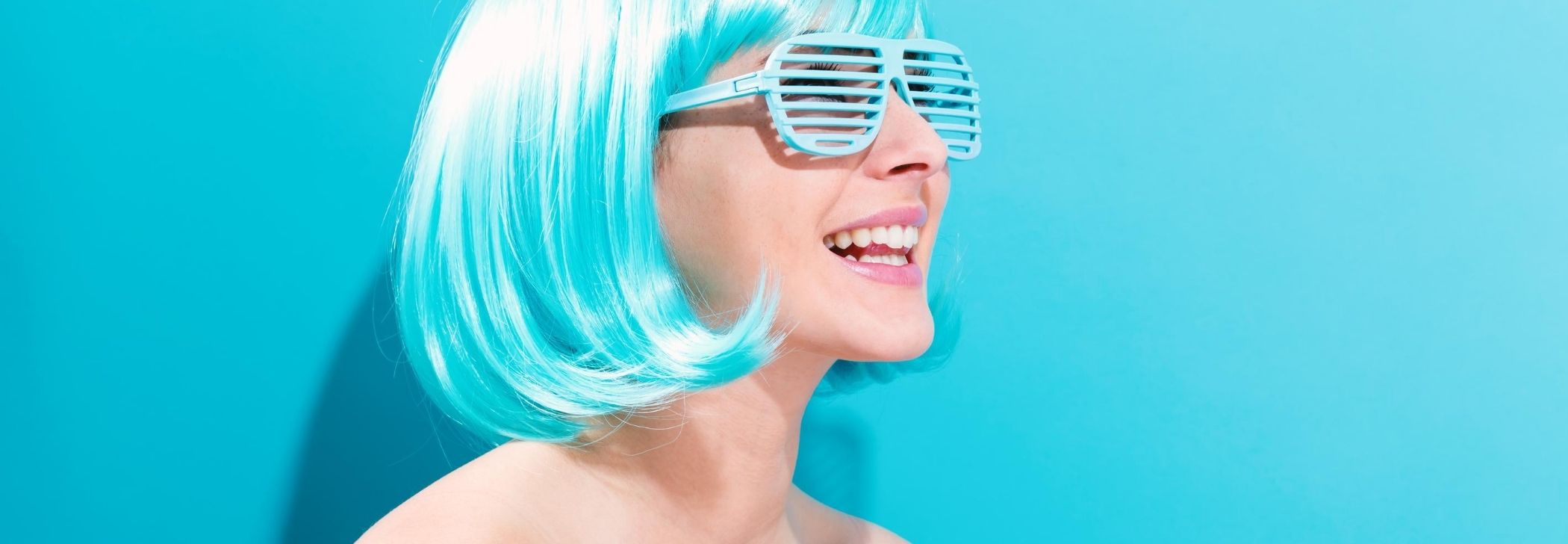
How to Choose the Perfect Creative Hair Colour
Changing the shade of your hair is not a recent invention. Humans have been doing this for thousands of years. Some of the earliest records of lightening or darkening tresses come from Ancient Egyptians, Greeks, and Romans.
Fast forward to the 21st Century, and you’ll find not much has changed, aside from the advances in colouring technology. Our desire and reasons for colouring our hair, deep down, have hardly ever altered. In this day and age, people dye their tresses for a few reasons, including but not limited to:
- Self-expression
- Preference
- Hiding silver strands
With the myriad of pigments that can now be reflected on your locks, why shouldn’t people change their experiment with different hues and styles? Read on to find out how you can choose the perfect shade to join in the fun!
4 Reasons to Choose Creative Colouring
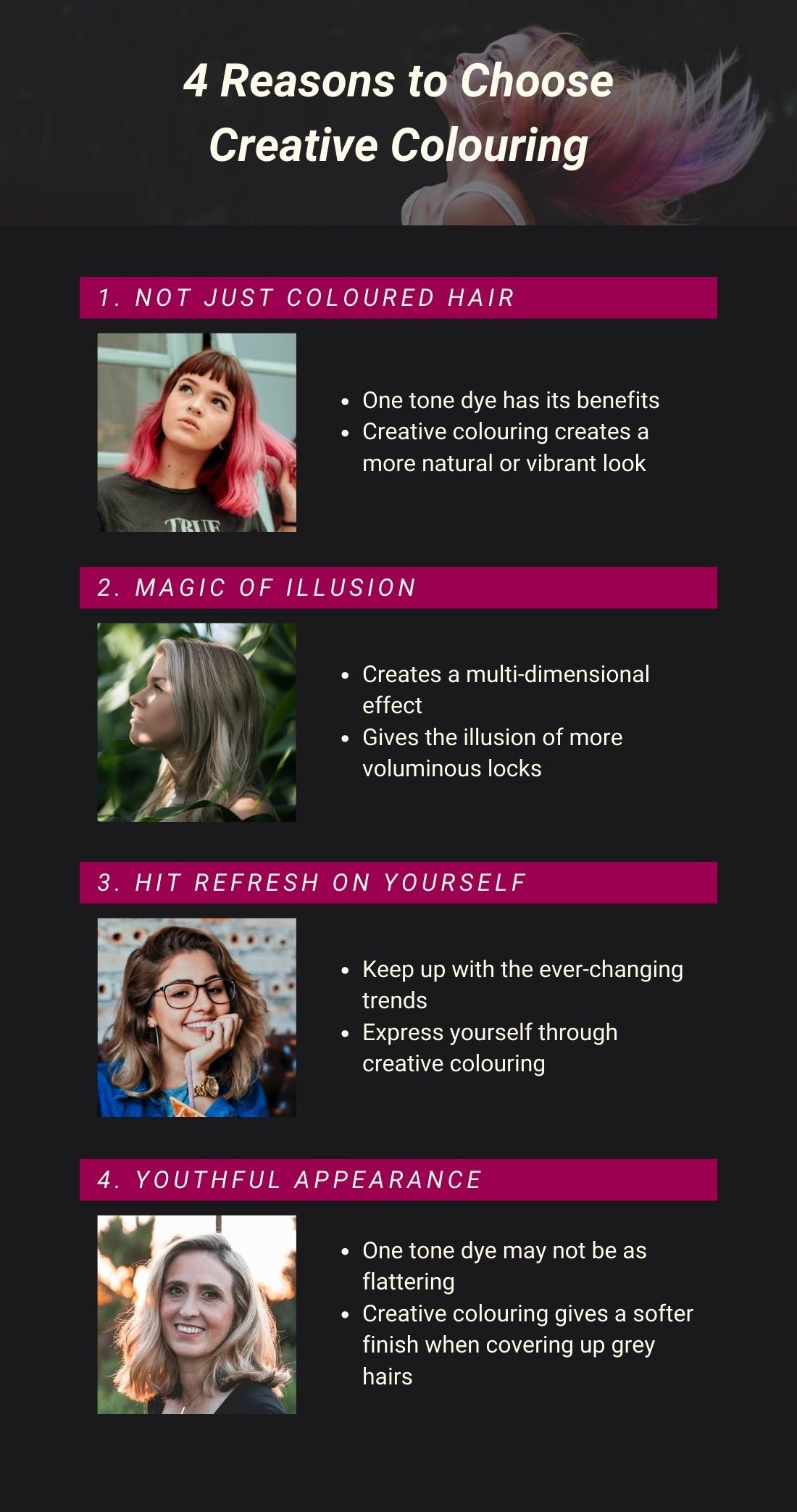
While hair dyeing has been around for centuries, modern creative colouring is a product of the 20th century that only became a commonplace from the 1970s. While past techniques leave much to be desired with their archaic and harmful methods, present-day solutions are significantly safer and come with a helpful list of aftercare.
On top of that, stylists of this age have better knowledge of hair and higher levels of skill as compared to those in the previous century. Throughout the years, creative colouring has definitely improved, thanks to innovation and technology. Here are four reasons why it is often a preferred choice:
1. Not Just Coloured Hair
Without a doubt, a one-tone dye job does what it is supposed to. Usually it is a solution to greying hairs or wanting to change the pigment of your entire head to one shade. However, it can come across as unexciting or one dimensional. Creative colouring, on the other hand, can give you a more natural look or a bubbly and vibrant look. With so many different techniques to choose from, you’ll be spoilt for choice!
2. Magic of Illusion
Adding multiple shades to your locks creates the illusion of more voluminous hair that has movement and dimension. Moreover, as your hair grows, this illusion even grows with you, ensuring that the results of your treatment are more natural looking.
3. Hit Refresh on Yourself
While everyone is beautiful the way they are, sometimes, a little change is not a bad thing. In today’s fast-paced world, getting bored or tired of your appearance is not unheard of. Whether it’s the new year (and the new you), a major transformation in your life, or you simply feel like expressing yourself, dyeing your tresses can feel like a refreshing change. Creative colouring makes all of these possible as the various techniques can deliver subtle but impactful results or bold and bright effects.
4. Youthful Appearance
Regular one-tone hues can cover up grey hairs, but the lack of dimension with one-tone locks may not be flattering, inadvertently causing you to look older than you are. In general, your locks are darker at the back of your head, compared to your hairline or crown, as that is the area that is least exposed to the sun. With creative colouring, you can try gentle highlights, ombré, or even balayage to achieve a natural and softer look.
3 Popular Techniques in Recent Years
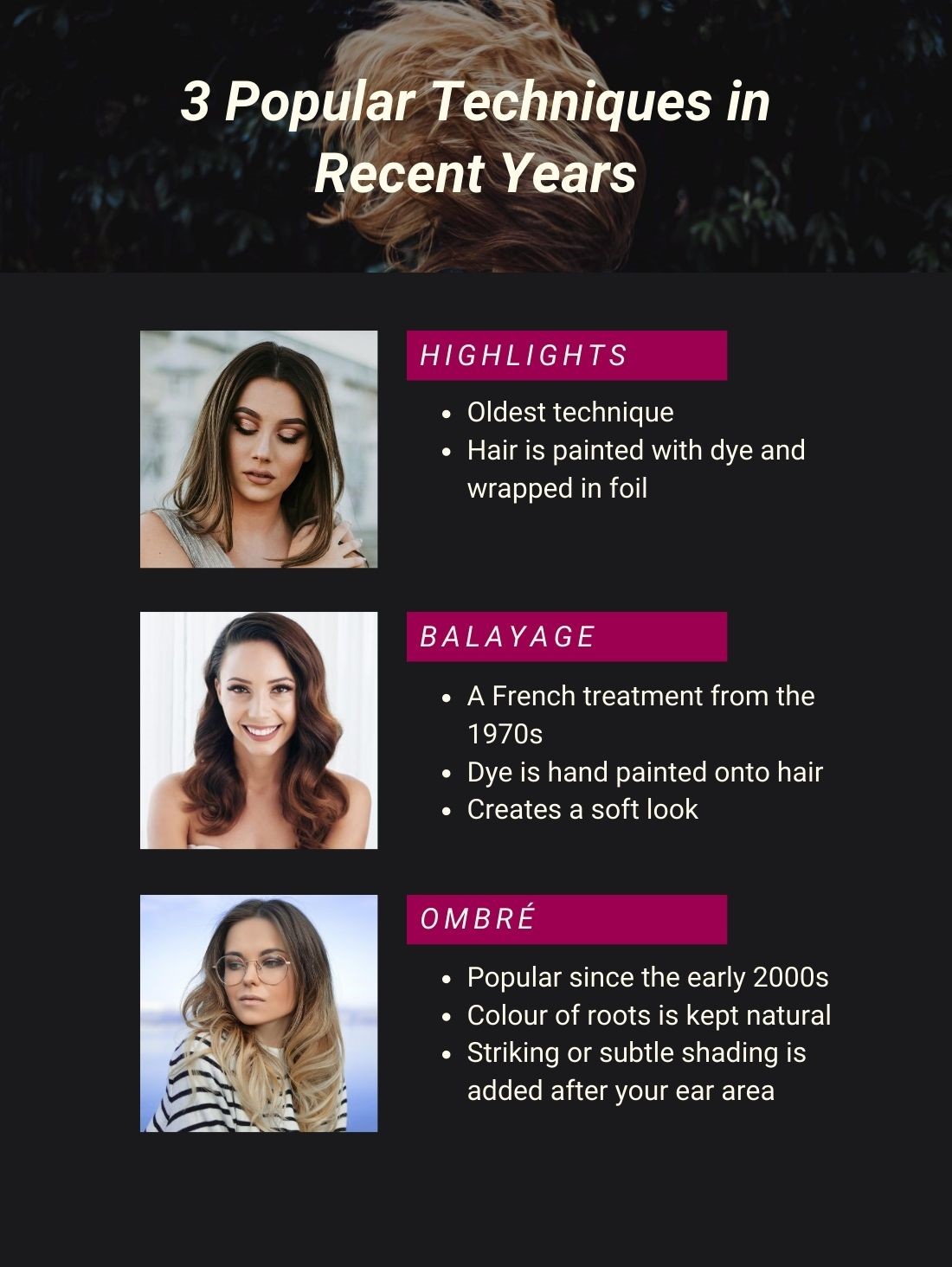
Fashion trends come and go; likewise, so do hair trends. Despite that, there are some that stick around longer than expected and become staples in salons.
The past decade has brought some truly delightful styles to us. Some iconic techniques that we witnessed were unicorn and mermaid hair (also known as ombré), the return of balayage, and the evolution of highlights.
Do note that popular hair colours should not be confused with popular techniques. While the former refers to pigments that are trendy for a season, the latter refers to the method of creating these looks. Here are three techniques that have withstood the test of time:
1. Highlights
One of the oldest lightening techniques, highlights have existed for decades. While it is uncertain as to who invented this technique, a well-known trick was to apply lemon juice on your tresses and allow the sun to lighten the acid-soaked strands. In the 1960s, salons did this using a plastic cap. Thankfully, times have changed! The chunky highlights of the early 2000s left much to be desired, but their evolution is why this technique still reigns today. Now, this method requires the use of wrapping strands in foil after application of the dye. You will achieve attractive contrasts in your hair with depth and dimension.
2. Balayage
In the past ten years, we have seen the return of this technique — the balayage. Derived from the French word for sweeping, balayage first came about in the 1970s in France. It is a freehand highlighting method whereby dye is hand painted onto an individual’s tresses. Not all the strands are painted through to the ends, creating a multi-dimensional illusion with light and dark shades. The result is soft and natural and lacks the regulated look often seen with normal highlights. Additionally, after undergoing this treatment, your locks grow out without any demarcation.
3. Ombré
Another French word, ombré is defined as shaded. This technique first entered our world in the late 2000s and has stayed till now. In general, your root shade is kept natural and the other shades are added, starting from the ear area. Other variations such as the subtler sombré and the coloured ombre — changing your base hue and matching shades to it — have also emerged. However, the traditional style is still an extremely popular colouring technique as the blend of various shades adds striking dimension.
Choosing Your Overall Look
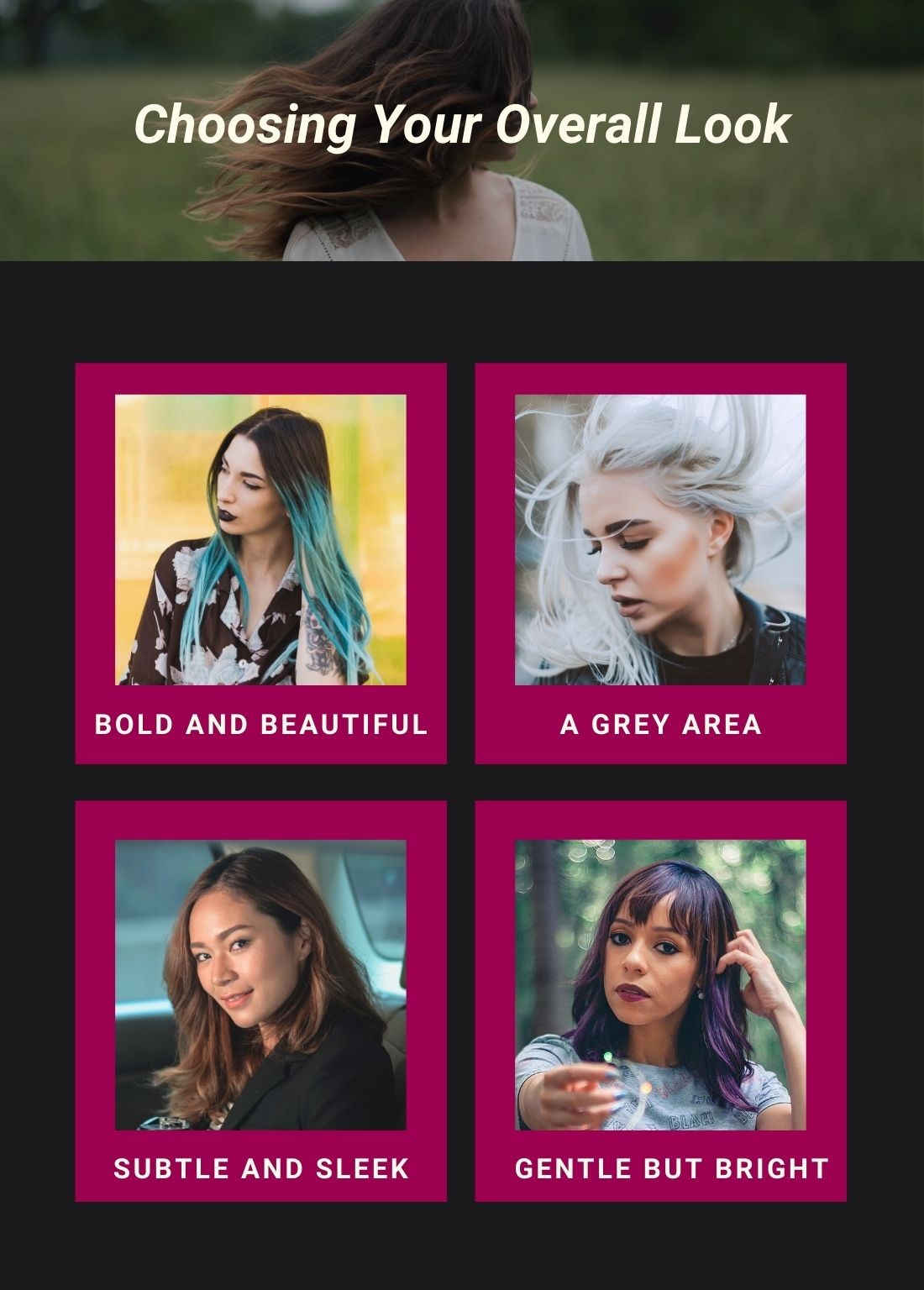
Now that you know more about creative colouring, it’s time to pick a colour combination. While scouring the internet for inspiration, you have probably come to realise that the colour combinations are endless! Your best bet would be to save a few pictures of your favourite styles and bring to your consultation appointment with your stylist.
Some things you should think of before picking a few ideal looks:
- Is your skin tone warm, cool, or neutral?
- Are you willing to undergo bleaching?
- Will you consider cutting your locks?
If you are not sure, you should bring these concerns up to your stylist. Whether you have a clear picture or not, here are some great options to get you started:
1. Bold and Beautiful
Say hello to vivid and colourful shades! Colouring your hair creatively is a great outlet for self-expression. For individuals who are not limited by anything, going bright is a terrific option. With the liberty to choose any combination of shades, you can discuss with your stylist during your consultation if you would like to go with some tried-and-tested options or venture on the path less taken. Some classic brilliant hues would be:
- Black base with blue tones as an ombré or highlights
- Blonde or brown base with rose-gold tones as a balayage or highlights
2. A Grey Area
Here’s the funny thing about colour trends: no shade is off limits. In recent years, grey hairs have no longer become something to hide. Contrary to popular belief, the sudden appearance of grey tresses is not always an indication of age. Some other possible reasons include stress, genes, and other health conditions. While some of us shy away from ashy strands with some grey coverage, others choose to embrace them! You can boost the natural beauty of your silver strands with a smoke-hued balayage or even a reverse ombré that is ashy on top and gradually darkens to a soft brown at the bottom. If you’re considering a splash of colour, try tinting a chunk of the end of your fringe in a vibrant shade!
3. Subtle and Sleek
Not everyone desires loud and colourful hair, but fret not because creative colouring is more flexible than you think. While many sport vibrant hues on their locks, this method can also do the opposite by tinting your tresses with delicate but distinctive shades. One way to achieve this is by sticking close to your base tone. For example, if your original or dyed locks are chocolate brown, the lighter shade should be a few shades paler, resulting in a sunkissed look with dimensions. Try these classy and gentle looks below that are also a great option for women who have limitations due to the regulations set by their work.
- Brown base with honey tones as balayage or ombré
- Black base with brown tones as balayage, ombré, or highlights
4. Gentle but Bright
The versatility of this method allows for one more variation. Above, we talked about a subtle look, however, it does not always mean sticking to darker pigments. Another option is to play with colours by choosing brighter colour combinations or even changing your base. Some options include:
- Brown base with bronze tones as a balayage or ombré
- Black base with purple or red tones as balayage, ombré, or highlights
What You Should Consider
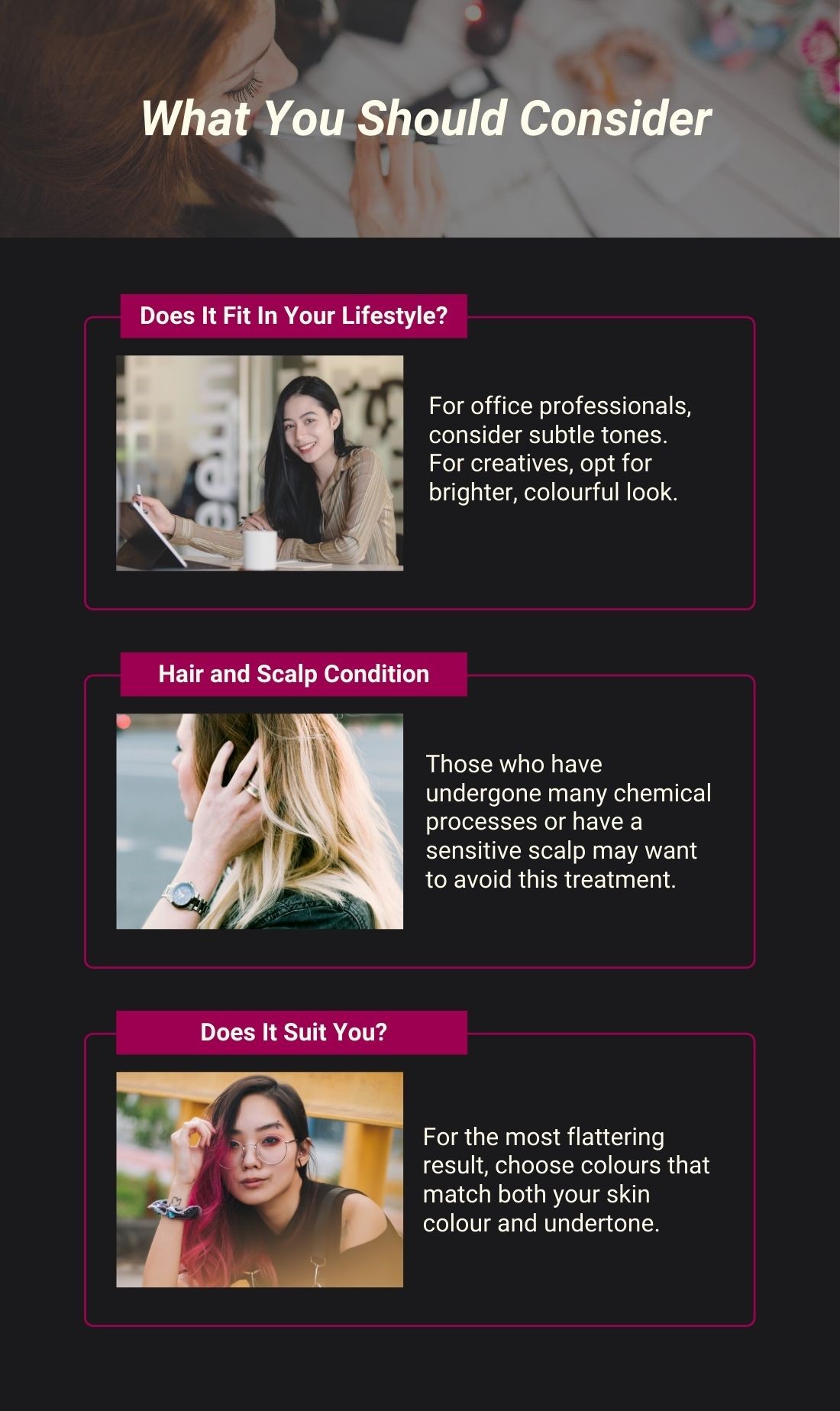
We all adore the amazing looks as seen on models and celebrities all over their social media and at red carpet events. But we also need to remember that there are certain considerations we have to take in before rushing off to book an appointment at the salon.
Here are three important factors you should mull over before making a decision:
1. Does It Fit in Your Lifestyle?
All individuals have different lifestyles that suit their needs. A vital consideration is whether the select look fits into your way of living. For example, if you are a professional working in the office, you may want to opt for subtler styles that elevate your look without being too distracting. If you are in more creative fields, having a brighter, colourful look will fit your work very nicely.
2. Hair and Scalp Condition
The process of dyeing can be a rigorous one that may take a toll on your locks. Individuals with sensitive scalps should either seek safer tinting options or stay away from this style as it can cause issues such as burning sensation, itching, or swelling. Additionally, if your locks have been put through many chemical treatments or are weak, more colouring might worsen its state causing dryness and breakage. On the other hand, if you have a healthy scalp and strong tresses, you’re good to go!
3. Does It Suit You?
Last but definitely not least, you have to choose a look that suits you. Since we are dealing with colour, you want to be sure that you choose pigments that suit your skin colour and undertone. Here are some general points about undertones that can help you make a choice:
- Cool undertone: If you are fair, choose warm and golden hues. If you are dark, choose cool reds and browns.
- Warm undertone: For fairer individuals try cool ashy or reddish tones. For darker individuals, select warm shades of copper or mahogany.
- Neutral undertone: Fortunately for you, you may pick from either cool or warm undertones. However this does not mean every shade will suit you.
The Final Takeaway
Aside from the treatments listed above, there are plenty more styles you can look at. The above methods are simply some of the most fashionable and time-prevailing techniques to try. Ultimately, it is more than evident that hair colouring is here to stay — but an added touch of creativity to it is always welcome.
Before going through with it, always ensure that you are confident that your selection suits you and that you can provide your precious locks with the necessary care and attention they need after. Do take comfort in the fact that you can seek an expert’s opinion here at YOON, should you be uncertain or stuck between shades. And most importantly, always remember that this should be a fun and exciting process for you!


